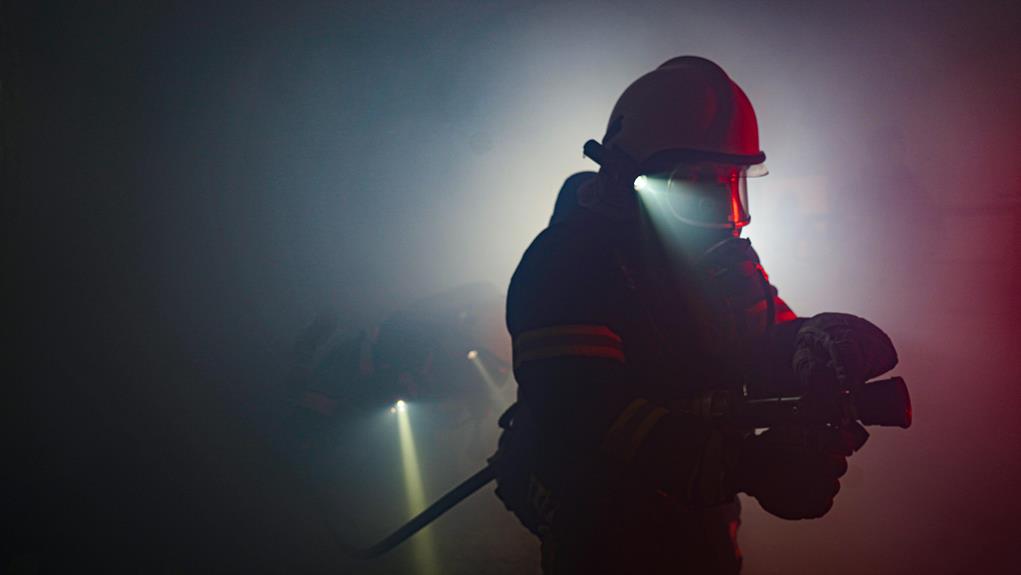The Chernobyl Exclusion Zone in Ukraine serves as a poignant evidence to the devastating consequences of the nuclear disaster that unfolded in 1986. This restricted area, shrouded in an eerie silence, beckons exploration of the abandoned remnants frozen in time. As visitors navigate through the desolate landscapes and deserted structures, they are confronted with a stark reminder of the fragility of human endeavors. However, beyond the visible scars lies a deeper narrative of resilience and adaptation, hinting at a complex interplay between human intervention and the relentless forces of nature.
Key Takeaways
- Chernobyl Exclusion Zone established post-1986 disaster.
- Area encompasses 30-km radius around the Chernobyl Nuclear Power Plant.
- Wildlife populations studied for radiation effects and ecosystem recovery.
- Visitors require protective gear and dosimeters for safety.
- Zone showcases abandoned city of Pripyat and nature's resilience.
The History of Chernobyl Disaster
The catastrophic nuclear accident that occurred at the Chernobyl Nuclear Power Plant in April 1986 remains one of the most significant incidents in the history of nuclear power. The causes of the Chernobyl disaster were attributed to a combination of design flaws in the reactor, human errors during a safety test, and a lack of proper safety protocols. The reactor's RBMK design, known for its instability at low power levels, allowed for a positive void coefficient, which means that as coolant water boiled and turned to steam, less neutrons were absorbed by the reactor, leading to increased reactivity.
Consequently, during a safety test to simulate a power outage scenario, operators committed critical errors in the control of the reactor, leading to a massive power surge and subsequent explosion. The consequences of the explosion were catastrophic, with a fire releasing large amounts of radioactive materials into the atmosphere. This radioactive fallout contaminated vast areas of Ukraine, Belarus, and Russia, leading to the evacuation and resettlement of over 300,000 people.
The environmental consequences of the Chernobyl disaster were far-reaching, with the release of radioactive isotopes causing long-term health effects on the surrounding populations and wildlife. The disaster also sparked global awareness of the risks associated with nuclear power and led to significant changes in safety regulations and reactor designs worldwide.
Impact on Surrounding Wildlife
The Chernobyl disaster had a profound impact on the surrounding wildlife due to the release of radioactive materials into the environment. The radioactive fallout contaminated vast areas, affecting wildlife habitats and leading to significant changes in the ecosystem. Initially, the levels of radiation were extremely high, causing immediate harm to many species. However, over time, nature has shown resilience, and some wildlife populations have started to rebound.
The Chernobyl Exclusion Zone, despite its challenges, has inadvertently become a unique scientific opportunity to study the long-term effects of radiation on wildlife. Researchers have observed both negative and positive impacts on different species. While some animals suffered from mutations and reproductive issues, others have thrived in the absence of human activity.
Wildlife habitats within the Exclusion Zone have undergone a transformation. The absence of human disturbance has allowed certain species to reclaim their territories, creating a sort of sanctuary within the contaminated area. This unexpected phenomenon has sparked discussions about ecosystem recovery and the delicate balance between human presence and wildlife preservation.
Ghost Town of Pripyat
Nestled within the Chernobyl Exclusion Zone lies the eerie and desolate Ghost Town of Pripyat, frozen in time since the nuclear disaster in 1986. This abandoned city once thrived with a population of around 50,000 people, primarily consisting of workers from the nearby Chernobyl Nuclear Power Plant and their families. Today, Pripyat stands as a haunting reminder of the tragic event that led to its abrupt evacuation.
—
| Abandoned Buildings | Urban Exploration |
|---|---|
| – Pripyat is home to numerous abandoned buildings, including schools, hospitals, and residential apartments. | – Urban exploration enthusiasts are drawn to Pripyat to witness firsthand the eerie atmosphere and the ravages of time on the deserted city. |
| – These structures serve as eerie time capsules, frozen in the state they were left over three decades ago. | – Explorers navigate through the decaying infrastructure, capturing glimpses of the past and reflecting on the human impact of the Chernobyl disaster. |
| – The ghostly remnants of daily life, such as children's toys scattered in kindergartens and forgotten belongings, evoke a sense of melancholy and contemplation. | – Despite the radiation risks, visitors and photographers venture into Pripyat to document the desolation and preserve the memory of a once-vibrant community. |
| – The abandoned buildings of Pripyat stand as silent witnesses to a catastrophic event that forever altered the course of history. | – Urban explorers tread carefully through the empty streets, honoring the legacy of those who once called Pripyat home. |
—
Radiation Levels and Safety Measures
Exploring the Ghost Town of Pripyat in the Chernobyl Exclusion Zone necessitates a meticulous understanding of the prevalent radiation levels and the imperative safety measures to mitigate potential risks. Radiation monitoring and adherence to strict safety protocols are vital for anyone entering the exclusion zone to safeguard their well-being. Here are some key points to ponder:
- Radiation Monitoring: Continuous monitoring of radiation levels is indispensable within the exclusion zone. Sophisticated equipment is used to detect any fluctuations in radiation, enabling authorities to alert individuals and evacuate if necessary.
- Protective Gear: Visitors must wear appropriate protective gear such as full-body suits, respirators, gloves, and shoe covers to minimize direct contact with contaminated surfaces and particles. This gear acts as a barrier against radioactive materials.
- Dosimeters: Every person entering the exclusion zone is required to carry a dosimeter to measure their radiation exposure levels accurately. This device provides real-time data and alerts individuals when they reach their safety limit.
- Decontamination Procedures: Upon exiting the zone, individuals undergo thorough decontamination procedures to remove any radioactive particles that may have attached to their clothing or skin, preventing potential exposure to radiation.
- Safety Briefings: Before entering the exclusion zone, visitors receive detailed safety briefings to educate them on radiation risks, safety protocols, and emergency procedures, ensuring they are well-prepared for any unforeseen situations.
Chernobyl Nuclear Power Plant
Within the Chernobyl Exclusion Zone, the Chernobyl Nuclear Power Plant stands as a stark reminder of the catastrophic events that unfolded on April 26, 1986. This facility, once intended to harness the power of nuclear energy for electricity generation, now symbolizes one of the worst nuclear disasters in history. The aftermath of the explosion at Reactor 4 resulted in significant environmental consequences that are still evident today.
To highlight the environmental impact of the Chernobyl Nuclear Power Plant disaster, consider the following table:
| Environmental Consequences | Description |
|---|---|
| Soil Contamination | Extensive radioactive fallout led to contaminated soil, affecting agriculture and wildlife. |
| Water Pollution | Radioactive isotopes entered water bodies, contaminating aquatic ecosystems and groundwater. |
| Forest Contamination | Pine trees near the plant turned reddish-brown ("Red Forest") due to high radiation levels. |
| Wildlife Effects | Animals within the Exclusion Zone experienced genetic mutations and population declines. |
The Chernobyl Nuclear Power Plant serves as a cautionary tale, showcasing the potential risks associated with nuclear energy production and the long-lasting environmental implications of a nuclear disaster. Despite efforts to contain the radiation and mitigate the impact, the legacy of Chernobyl continues to remind us of the delicate balance between harnessing the power of atoms and protecting our planet's ecosystems.
Tours and Visitor Information
The provision of guided tours within the Chernobyl Exclusion Zone offers visitors a unique opportunity to witness firsthand the lasting effects of the nuclear disaster and the ongoing efforts to manage its environmental impact. These tours provide a deep insight into the aftermath of the catastrophic event, allowing tourists to engage with the site in a meaningful way.
- Tourist experiences: Visitors can explore the abandoned buildings, such as schools and hospitals, frozen in time since the evacuation, providing a haunting yet educational experience.
- Safety precautions: Stringent safety measures are in place to safeguard visitors from radiation exposure, including designated pathways and mandatory protective gear to guarantee a secure touring environment.
- Local communities: Interaction with the residents who chose to return to the outskirts of the zone sheds light on their resilience and the challenges they face living in such proximity to a nuclear disaster site.
- Cultural heritage: The tours also highlight the rich cultural history of the region, showcasing traditional Ukrainian customs and the significance of the area before the disaster struck.
- Environmental impact: Observing the wildlife and vegetation reclaiming the abandoned spaces underscores the resilience of nature in the face of human-made catastrophe, offering a glimmer of hope for the future.
The Resilience of Nature
Nature's remarkable ability to rebound and thrive in the aftermath of the Chernobyl nuclear disaster serves as proof of its enduring resilience in the face of adversity. Despite the catastrophic event that occurred in 1986, the Chernobyl Exclusion Zone has become a living laboratory showcasing the power of nature to restore itself. The area, once considered a desolate wasteland, is now teeming with life, demonstrating the intricate balance and resilience of ecosystems.
One of the most striking aspects of nature's recovery in the Chernobyl Exclusion Zone is the restoration of ecological balance. The absence of human interference has allowed for the re-establishment of natural processes, leading to the revival of various plant and animal species. This resurgence has resulted in a harmonious coexistence where wildlife thrives without the pressures of human development.
Moreover, biodiversity recovery in the Chernobyl Exclusion Zone is a confirmation to the resilience of nature. Over the years, scientists have documented the return of numerous species, some of which were previously thought to have vanished from the area. From wolves and bears to rare bird species, the diverse ecosystem within the exclusion zone highlights nature's ability to adapt and reclaim its territory.
Future of the Exclusion Zone
With the passing of time since the Chernobyl nuclear disaster, the Exclusion Zone has emerged as a unique case study for understanding the long-term environmental implications of such catastrophic events. The future of the Exclusion Zone holds both challenges and opportunities as efforts are made to shape its trajectory.
- Repopulation Plans: There have been discussions about potentially allowing limited human presence in certain areas of the Exclusion Zone, primarily for research purposes. However, the feasibility and safety of such repopulation plans remain subjects of intense debate.
- Economic Opportunities: The Exclusion Zone presents a paradoxical opportunity for economic activities such as tourism. While this could bring much-needed revenue to the region, it also raises concerns about the ethical implications of capitalizing on a site of such tragedy.
- Wildlife Conservation: The absence of human activity in the Exclusion Zone has inadvertently created a haven for wildlife. Efforts are underway to study and protect the thriving ecosystems within the Zone.
- Technological Advancements: The Exclusion Zone serves as a testing ground for innovative technologies in radiation monitoring, cleanup, and containment. These advancements could have far-reaching implications for future nuclear disaster response strategies.
- International Collaboration: The future of the Exclusion Zone necessitates global cooperation. Collaborative efforts in research, monitoring, and policy development are essential to guarantee the long-term safety and preservation of this unique environment.
Frequently Asked Questions
Can Visitors Bring Their Own Food and Drinks Into the Exclusion Zone?
Visitors may bring their own food and drinks into the exclusion zone. This provides freedom of choice in dining options and allows visitors to enjoy local cuisine or engage in picnics at designated spots. Bringing personal food supplies also facilitates outdoor dining experiences while exploring the area.
It is advisable to follow any regulations in place regarding food storage and waste disposal to guarantee the preservation of the environment within the exclusion zone.
Are There Any Restrictions on Photography in the Chernobyl Exclusion Zone?
When considering the restrictions on photography in certain areas, it is essential to acknowledge the balance required between providing photo opportunities and respecting cultural significance while minimizing environmental impact and protecting wildlife presence.
Understanding the nuances of photography regulations in sensitive locations contributes to the preservation of natural habitats and historical sites, ensuring that future generations can enjoy these spaces responsibly.
What Happens to the Buildings and Structures Within the Zone Over Time?
Over time, buildings and structures undergo a natural decay process, influenced by environmental factors like weathering and vegetation growth. This progression can lead to structural instability and eventual collapse.
As these man-made structures deteriorate, they create opportunities for the development of wildlife habitats within the vicinity. This transformation from human-made to natural environments highlights the resilience and adaptability of ecosystems in reclaiming and repurposing abandoned spaces.
Is There Internet and Mobile Phone Reception Available in the Area?
Communication options within certain remote or restricted areas may present connectivity challenges. In such locations, the availability of online access and signal strength can vary greatly.
Factors such as geographical features and infrastructure limitations can impact the reliability of internet and mobile phone reception. Understanding the nuances of these conditions is essential for individuals seeking to stay connected while maneuvering environments with potential communication constraints.
Are There Any Specific Rules or Etiquette That Visitors Should Follow During Tours?
Finding the delicate balance between exploration and respect forms the crux of tourist behavior within unique environs. Understanding cultural norms and following established guidelines are paramount for an enriching experience. Visitors should adhere to rules governing behavior, preserving the sanctity of the space and honoring its historical significance.
Conclusion
To sum up, the Chernobyl Exclusion Zone serves as a chilling demonstration of the enduring impact of the 1986 nuclear disaster.
Despite the devastation, the area showcases a remarkable resilience in the face of adversity.
The eerie remnants of the past stand as a stark reminder of the dangers of nuclear power, while also highlighting the ability of nature to reclaim and thrive in even the most inhospitable environments.


